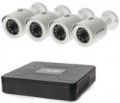Max. capacity
The largest storage capacity with which the recorder is able to work normally.
The more capacious the drive, the higher the processing power of the system in which it is used should be. Therefore, any modern registrar has limitations on disk capacity. However, even in the most modest models, this figure is about 2 TB, in most cases this is quite enough to work with the capabilities provided in this particular registrar.
Camera model
A model of pointed cameras supplied with a video surveillance kit. Knowing this data, you can find detailed information on the cameras and clarify their characteristics. Also, if you buy additional cameras of the same model, you don't have to worry about compatibility.
Matrix size
The physical size of the sensor in the pointed cameras is diagonally, in inches (fractions of an inch).
The larger the sensor, the less prone it is to noise, the better image quality it can provide, and the better it is suited to low light conditions. This is due to the fact that each individual pixel gets more light, because. on a large matrix and individual dots are larger. On the other hand, large matrices are more expensive.
Number of megapixels
Sensor resolution of pointed cameras in megapixels (millions of pixels).
Higher resolution allows you to get a more detailed "picture". However, increasing the number of megapixels without increasing the sensor size can result in poor overall image quality and noise, especially in low light. Therefore, in itself, the high resolution of the matrix does not guarantee high quality shooting.
RCA audio input
The number of
RCA audio inputs provided in the design of the complete recorder.
The presence of such connectors allows the recorder to receive an analogue audio signal from cameras that have the ability to capture sound, or from separately made microphones. It is worth looking for a set with such capabilities in cases where it is critical to record not only the picture, but also the sound during observation. Note that the number of RCA inputs may correspond to the number of BNC connectors (see above), but may be less.
HDMI
The number of
HDMI connectors provided in the design of the complete registrar.
The HDMI interface is actually a standard for modern video equipment, it is widely used in TVs, monitors, projectors, etc. Usually, in modern registrars we are talking about HDMI outputs. This output allows you to broadcast a digital signal to an external screen, such as a TV; at the same time, both video and audio are transmitted via a single cable, and the bandwidth is enough to work with HD resolutions and multi-channel audio. The recorder itself can be used as an external video player, to play the footage, or directly broadcast video / audio from the camera (cameras) via HDMI. Models where there are more than one such outputs are practically never found.
Recording resolution
The maximum frame resolution in which the complete recorder can record video if all video channels are involved in operation. In fact, we are talking about the highest resolution in maximum load mode; if some channels are idle, some models allow higher resolutions. However, it is customary to indicate this parameter in the specifications - it most accurately characterizes the capabilities of the device.
As for the resolution itself, the higher it is, the more detailed the image is; on the other hand, such video requires significant processing power and capacious storage drives, which affects the final cost of the equipment.
Popular maximum frame resolutions in which modern recorders record:
HD (720),
Full HD (1080),
Quad HD,
Ultra HD (4K).

